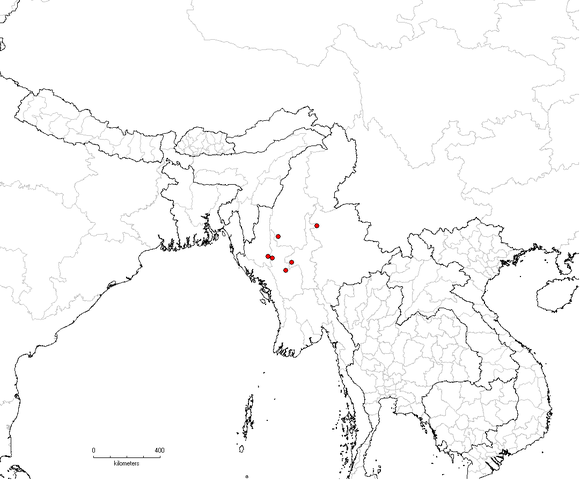Nomenclature
Accepted name/Authority/Place of publication:
Blinkworthia convolvuloides Prain, J. Asiat. Soc. Bengal 63(2): 91. 1894.
Synonyms:
Blinkworthia discostigma Handel-Mazzetti.
Description
Habit:
Climbers or trailers, woody. Stems to 12 m long. Branches flexuous, slender, strigose or villous.
Leaves:
Petiole 3–4 mm; leaf blade elliptic to oblong, 3–5(–14) × 1–1.8(–8.5) cm, leathery, abaxial surface strigose, adaxial surface glabrous, base rounded, apex obtuse and mucronulate.
Inflorescences:
Pedicel curved, 8–10 mm, glabrous; bracteoles at middle, 3 or 4, spatulate, 5–6 mm, strigose abaxially.
Flowers:
Sepals ovate to circular, 6–7 mm, sparsely strigose, base nearly cordate, margin translucent, apex obtuse. Corolla white, pale green, or yellow, 1.7–2 cm, with 5 distinct, ± fleshy, midpetaline bands. Stamens adnate to corolla tube for 1/2 their length; filaments filiform, base slightly dilated and verruculose; anthers longitudinally dehiscent. Pistil shorter than stamens.
Fruits:
Berry ovoid, 8–10 mm in diam.
Seeds:
Seeds 1–4, ovoid, glabrous.
References:
Fang R.C., G. Staples, et al. 1995. Convolvulaceae in P. Raven & C.Y. Wu (eds.) Flora of China 16: 271–325.
Biogeography, Ecology and Natural History
Distribution Map:

Distribution:
China (S Guangxi, S Yunnan), Myanmar.
Ecology:
Thickets,
savanna forests; 400–600(–2500) m.
References:
Fang R.C., G. Staples, et al. 1995. Convolvulaceae in P. Raven & C.Y. Wu (eds.) Flora of China 16: 271–325.
Other information
Common names and uses:
bao ye teng (Chinese).
The roots and leaves are used locally for treating stomach ache.
General comments:
Most herbarium specimens seen have leaf blades within the size range reported above. Recent collections from Myanmar with full-sized cauline leaves attached revealed that the size is much greater. Typically, when flowering parts are collected the cauline leaves are omitted.
Authorship for webpage
Editor:
George Staples, Esmond Er
Contributors:

Classification:

Add new comment